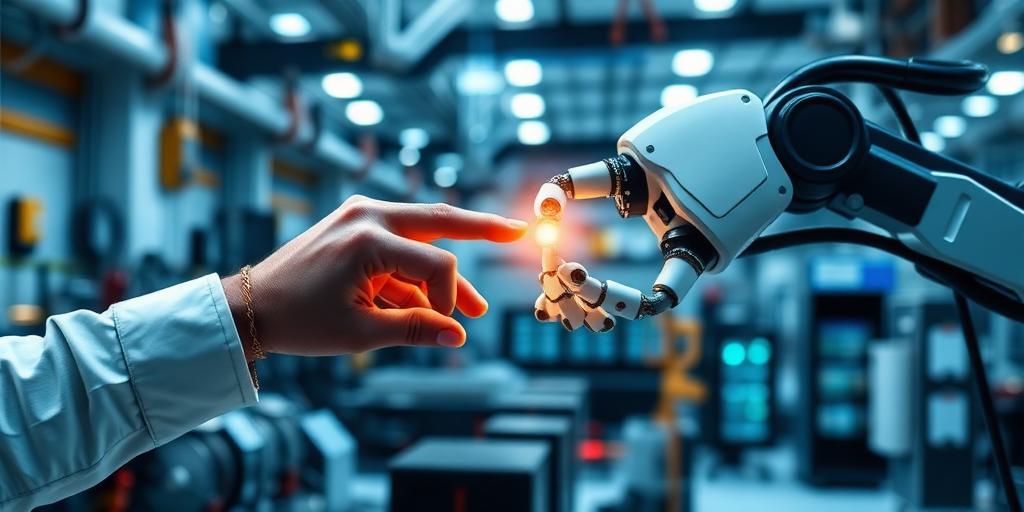Understanding the Future of Human-Robot Collaboration
The convergence of human ingenuity and robotic precision is rapidly reshaping industries, promising unprecedented levels of efficiency and innovation. Human-robot collaboration (HRC) is no longer a futuristic concept but a present-day reality, poised to redefine how we work and interact with machines.
The Current Landscape of HRC
Currently, HRC spans various sectors, from manufacturing to healthcare. In manufacturing, collaborative robots, or cobots, work alongside humans on assembly lines, handling repetitive or physically demanding tasks while humans focus on intricate operations and quality control. In healthcare, robots assist in surgeries, dispense medication, and provide support to patients, enhancing precision and reducing the workload on medical staff.
Key Benefits of Human-Robot Collaboration
- Increased Efficiency: Robots excel at performing repetitive tasks with speed and accuracy, freeing up human workers to focus on more complex and creative activities.
- Enhanced Safety: Robots can handle dangerous or hazardous tasks, reducing the risk of workplace accidents and injuries.
- Improved Quality: Robots maintain consistent performance, leading to higher quality products and services.
- Greater Flexibility: HRC allows for more flexible production processes, adapting to changing demands and customer needs.
- Better Job Satisfaction: By automating mundane tasks, HRC can lead to more fulfilling and engaging jobs for human workers.
Challenges and Considerations
Despite the numerous benefits, HRC also presents several challenges that need to be addressed:
- Safety Protocols: Ensuring the safety of human workers in collaborative environments requires robust safety protocols and technologies.
- Integration Complexity: Integrating robots into existing workflows can be complex and require significant investment in training and infrastructure.
- Job Displacement Concerns: Addressing concerns about job displacement through retraining and upskilling programs is crucial for the successful adoption of HRC.
- Ethical Considerations: As robots become more integrated into the workforce, ethical considerations around autonomy, decision-making, and data privacy must be carefully addressed.
Technological Advancements Driving HRC
Several technological advancements are driving the evolution of HRC:
- Advanced Sensors and Vision Systems: These technologies enable robots to perceive their environment and interact safely with humans.
- Artificial Intelligence (AI): AI algorithms allow robots to learn from experience, adapt to new situations, and make autonomous decisions.
- Improved Human-Machine Interfaces: Intuitive interfaces make it easier for humans to program, control, and interact with robots.
- Cloud Robotics: Connecting robots to the cloud enables them to share data, collaborate with other robots, and access advanced AI capabilities.
The Future of HRC
The future of HRC is envisioned as a seamless integration of human and robotic capabilities, where robots become intelligent assistants that augment human skills and creativity. Key trends shaping this future include:
- More Intuitive Collaboration: Robots will become more intuitive to work with, understanding human intent and adapting to human behavior.
- Greater Autonomy: Robots will be able to perform more complex tasks autonomously, requiring less human supervision.
- Personalized HRC: Robots will be customized to meet the specific needs of individual workers and tasks.
- HRC in New Industries: HRC will expand into new industries, such as agriculture, construction, and logistics.
Conclusion
Human-robot collaboration holds immense potential to transform industries and improve the way we work. By addressing the challenges and embracing the opportunities, we can create a future where humans and robots work together to achieve unprecedented levels of productivity, innovation, and job satisfaction. The key lies in fostering a collaborative ecosystem that prioritizes safety, ethical considerations, and the continuous development of human skills to thrive in this evolving landscape. The future is not about humans versus robots, but about humans with robots.









